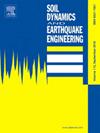Structural damages during the February 06, 2023 Kahramanmaraş Earthquakes in Turkey
IF 4.2
2区 工程技术
Q1 ENGINEERING, GEOLOGICAL
引用次数: 0
Abstract
On February 6, 2023, two very destructive earthquakes by 9 h apart, Mw 7.8 Pazarcık and Mw 7.7 Elbistan (Kahramanmaraş Earthquakes), struck southeastern Turkey, causing more than 50 thousand loss of lives, 40 thousand collapsed and more than half a million damaged buildings. Our research team conducted a site investigation at the earthquake-hit area and this paper presents common structural damages observed at site. Seismological characteristics of the earthquakes was presented and spectral accelerations formed by using strong ground motion records were shared with design spectrums by Turkish Seismic Design Code 2018 (TSDC2018). In certain locations, response acceleration spectra of the ground motion exceeded elastic design spectrum values in the current TSDC2018 (sometimes exceeded maximum earthquake level DD1). Some new buildings designed in accordance with TSDC2018 were hit by a greater seismic load and heavily damaged/collapsed during Kahramanmaraş Earthquakes. However, most of new structures, which were designed and constructed to ensure high ductility and owing to their existing reserve capacities, were able to survive the earthquakes and prevented loss of lives even though, many of them were heavily damaged. Nonlinear time history analysis was conducted to determine seismic performance of six storey buildings, which were designed by TSDC2018 considering both design (DD2) and maximum (DD1) earthquake levels, with return periods of 475 and 2475 years. A construction cost comparison was also conducted for RC buildings, which were designed by two (DD2, DD1) earthquake levels, respectively. As a result of the conclusions made throughout the study, the current seismic design procedure for regular RC buildings located in high risk seismic regions should be reevaluated to enhance their seismic resilience.
求助全文
约1分钟内获得全文
求助全文
来源期刊

Soil Dynamics and Earthquake Engineering
工程技术-地球科学综合
CiteScore
7.50
自引率
15.00%
发文量
446
审稿时长
8 months
期刊介绍:
The journal aims to encourage and enhance the role of mechanics and other disciplines as they relate to earthquake engineering by providing opportunities for the publication of the work of applied mathematicians, engineers and other applied scientists involved in solving problems closely related to the field of earthquake engineering and geotechnical earthquake engineering.
Emphasis is placed on new concepts and techniques, but case histories will also be published if they enhance the presentation and understanding of new technical concepts.
 求助内容:
求助内容: 应助结果提醒方式:
应助结果提醒方式:


